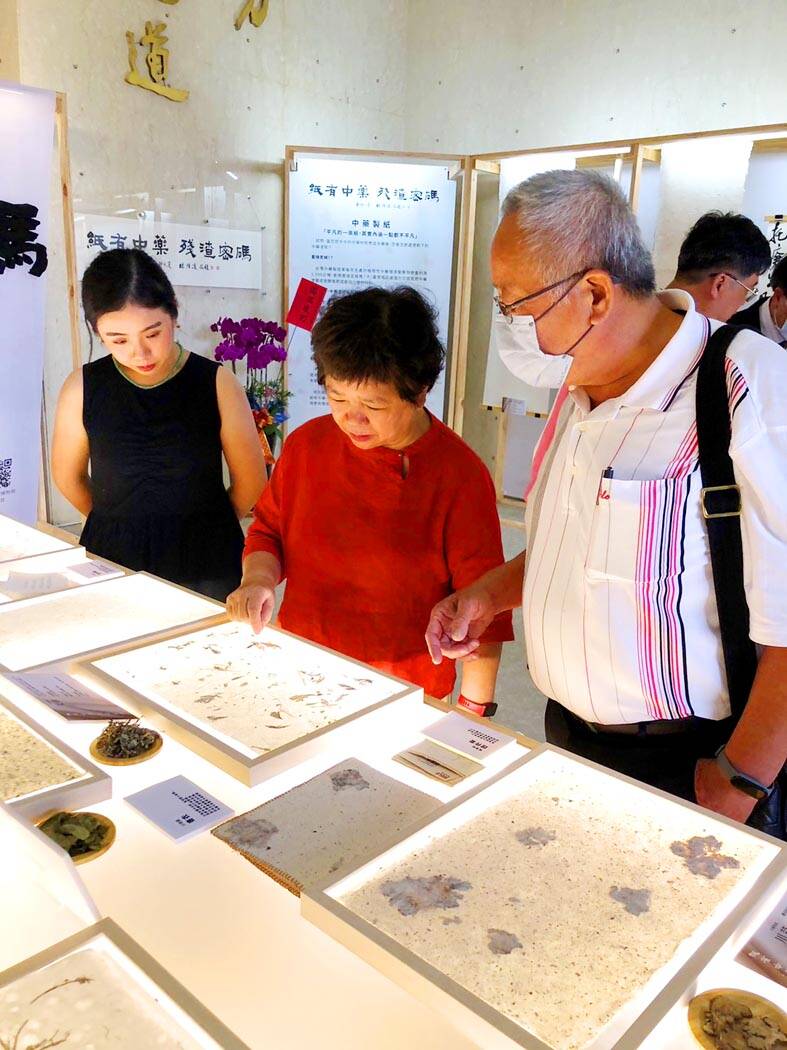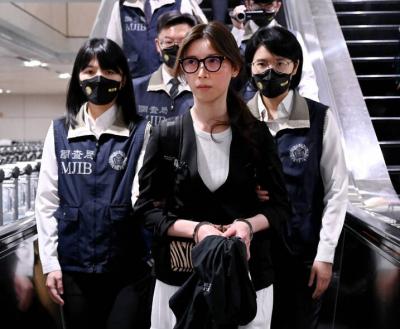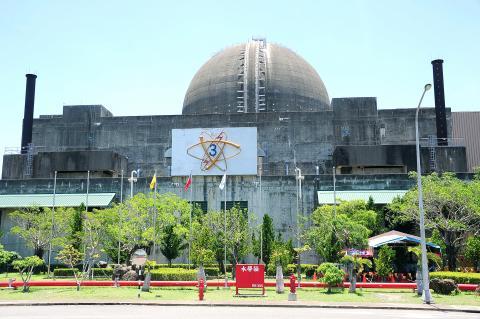The museum on the campus of China Medical University (CMU) in Taichung is hosting an exhibition featuring pieces of paper that were handmade using the dregs of Chinese medicine and have a unique herbal aroma.
The exhibition, titled “Paper with Chinese Medicine Dregs in Cipher,” runs until Oct. 31 at the Lifu Museum of Chinese Medicine on CMU’s campus, the museum said in a statement yesterday.
Taiwan’s Chinese medicine-making industry produces about 1,500 tonnes of dregs from herbal medicine a year, the museum said, not specifying the source of that figure.

Photo courtesy of China Medical University
The dregs left over from the production of Chinese medicine are fiber-rich plant roots, stems and leaves, and the most common way of disposing of them is to turn them into compost or planting materials, it said.
Driven to find other ways to make use of the leftovers, the museum came up with the idea of working with Taiwan’s veteran Guang Xing Paper Mill to produce paper, museum director Kao Sheng-te (高尚德) was cited in the statement as saying.
The museum also collaborated with Japanese retailer MUJI to craft goods from the new type of paper, Kao said.
CMU president Hung Mien-chie (洪明奇) touted the success of making paper using herbal residue as a highlight in the quest to make sustainable goods, while Guang Xing CEO Huang Chi (黃琪) called the idea a breakthrough in sustainable production.
The exhibition is divided into three zones that focus on sustainability, fragrance and vision, the museum said.
Unsing a special production method, the unique aroma of the dregs from Chinese herbal medicine are preserved in the paper, it said, adding that it is also possible to see evidence of the plant substances used — such as flower petals — on the paper.
About 20 types of Chinese medicinal herbs were used to make the paper, including dried ginger, the root of membranous milk vetch, Chinese angelica and cinnamon bark, the museum said.
Some of the Chinese medicine materials used can replace 80 percent of virgin pulp and the paper can be used for writing and handicrafts, among other applications, it added.

A fugitive in a suspected cosmetic surgery fraud case today returned to Taiwan from Canada, after being wanted for six years. Internet celebrity Su Chen-tuan (蘇陳端), known as Lady Nai Nai (貴婦奈奈), and her former boyfriend, plastic surgeon Paul Huang (黃博健), allegedly defrauded clients and friends of about NT$1 billion (US$30.66 million). Su was put on a wanted list in 2019 when she lived in Toronto, Canada, after failing to respond to subpoenas and arrest warrants from the Taipei District Prosecutors’ Office. Su arrived at Taiwan Taoyuan International Airport at 5am today on an EVA Air flight accompanied by a

An essay competition jointly organized by a local writing society and a publisher affiliated with the Chinese Communist Party (CCP) might have contravened the Act Governing Relations Between the People of the Taiwan Area and the Mainland Area (臺灣地區與大陸地區人民關係條例), the Mainland Affairs Council (MAC) said on Thursday. “In this case, the partner organization is clearly an agency under the CCP’s Fujian Provincial Committee,” MAC Deputy Minister and spokesperson Liang Wen-chieh (梁文傑) said at a news briefing in Taipei. “It also involves bringing Taiwanese students to China with all-expenses-paid arrangements to attend award ceremonies and camps,” Liang said. Those two “characteristics” are typically sufficient

A magnitude 5.9 earthquake that struck about 33km off the coast of Hualien City was the "main shock" in a series of quakes in the area, with aftershocks expected over the next three days, the Central Weather Administration (CWA) said yesterday. Prior to the magnitude 5.9 quake shaking most of Taiwan at 6:53pm yesterday, six other earthquakes stronger than a magnitude of 4, starting with a magnitude 5.5 quake at 6:09pm, occurred in the area. CWA Seismological Center Director Wu Chien-fu (吳健富) confirmed that the quakes were all part of the same series and that the magnitude 5.5 temblor was

Restarting the No. 2 reactor at the Ma-anshan Nuclear Power Plant would take up to 18 months, Minister of Economic Affairs J.W. Kuo (郭智輝) said today. Kuo was answering questions during a meeting of the Legislative Yuan’s Economics Committee, where legislators are considering amendments to the Renewable Energy Development Act (再生能源發展條) amid concerns about the consequences of the Pingtung County reactor’s decommissioning scheduled for May 17. Its decommissioning is to mark the end of Taiwan’s nuclear power production. However, Chinese Nationalist Party (KMT) lawmakers have proposed an amendment to the Nuclear Reactor Facilities Regulation Act (核子反應器設施管制法) that would extend the life of existing